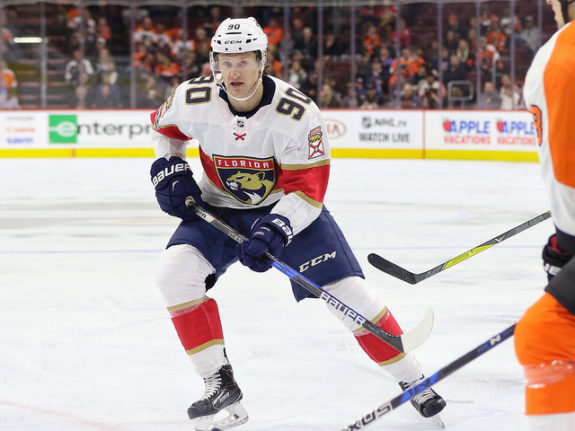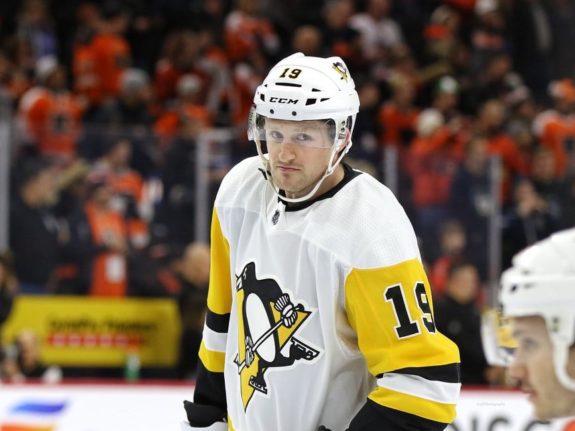The 2013-14 season saw the end of a five-year playoff streak for the Vancouver Canucks. As a result, the team ended up drafting sixth overall at the 2014 NHL Draft, selecting forward Jake Virtanen. The Canucks had one more pick in the first round of the 2014 NHL Draft, which they acquired through a trade with the Anaheim Ducks for 2011 Selke Trophy winner Ryan Kesler. With the 24th overall pick, they selected forward Jared McCann.
McCann In Vancouver
McCann played one full season in Vancouver in 2015-16, scoring nine goals and 18 points in 69 games. The Canucks traded him to the Florida Panthers along with a 2016 second-round pick and a 2016 fourth-round pick for defenceman Erik Gudbranson and a 2016 fifth-round pick (used to select Cole Candella). General manager Jim Benning made the trade for multiple reasons. One was the need for a top-4 defenceman.
“It was a steep price to pay from our end. We really like Jared McCann as a player, but we have been taking a lot of phone calls the last couple of weeks, and to add a top-four defenseman to our group wasn’t going to be something that was going to be easy.”
Jim Benning said about the trade.
During his time with the Canucks, Gudbranson proved to not be the top-four defenceman Benning had hoped he would be. The 6-foot-5 defender was traded midway through his third season to the Pittsburgh Penguins for Tanner Pearson.
The other reason the Canucks traded McCann, who was 19 at the time, was his immature behaviour off the ice. The forward told The Athletic he had to mature quickly due to being traded at just 19 years of age but still had a tough time creating relationships in Florida (from ‘The Armies: The rise and fall of the Canucks’ Pittsburgh empire and the Jared McCann exclusive,’ The Athletic, November 27, 2019).
“Hockey-wise, I think, I was ready for that part, but off the ice, I made a lot of mistakes. There were a lot of relationships that I wish I’d taken differently … but I mean I was a young immature kid. A lot of guys go through that, but obviously it was different because I was traded after my first year, so I wasn’t able to mend those relationships. Show them that they don’t know what kind of person I am.”
McCann told The Athletic.
Time In Florida
While the Canucks continued to finish at the bottom of the standings with Gubranson on their roster, McCann spent the next two and a half-seasons with the Panthers.

In his first season with his second NHL team, he split time between the NHL and AHL. He scored one goal and posted seven points in 29 games with the Panthers, while in the AHL, he scored 11 goals and 25 points in 42 games with the Springfield Thunderbirds. The following season he played 68 games with the Panthers, scoring nine goals and posting 28 points. His third and final season saw him playing 46 games before being traded to Pittsburgh. He scored eight goals and posted 18 points.
The Panthers shipped the young forward to Pittsburgh along with Nick Bjugstad for Derick Brassard, Riley Sheahan, a 2019 second-round pick, Penguins 2019 fourth-round pick, and Minnesota Wild’s 2019 fourth-round pick.
Thriving In Pittsburgh
Finishing off the 2018-19 season, McCann played well as a depth forward. He scored 11 goals and posted 17 points, which when added to his season total, gave him a career-high with 19 goals and 35 points in 78 games. The following season, he continued to develop as a forward, scoring 14 goals and tying his career-high with 35 points in a shortened 66 game season. Had the 2019-20 season not come to an abrupt end due to COVID-19, he was on pace to posting a new career-high with 44 points.
McCann saw an increase in responsibility this season with the Penguins. With Evgeni Malkin injured on March 16th and Kasperi Kapanen injured a week later, McCann found an opportunity to step up. Since March 24th, he has posted nine goals and 22 points in the last 24 games of the season. Additionally, he led the team with six power-play goals in those games. He was on pace to scoring 27 goals and posting 61 points in a full 82 game season.

What makes McCann’s performance over the past 24 games even more impressive is he has stepped up to provide the team’s top line of Sidney Crosby, Jake Guentzel, and Bryan Rust with some secondary scoring.
Canucks Could Use a Third Line Centre
Had the Canucks allowed McCann to develop into the forward he is today, the team would have been in a great spot over the next few seasons. Although the club eventually added Pearson thanks to the McCann trade, the 24-year-old is a better fit for the current roster and the team moving forward. Thanks to his versatility as winger and centre, he can be moved from the top-six to the third line, providing the team with depth scoring.
The Canucks are in need of a third-line centre since their top-six should be good even without Pearson next season. Since the Lotto Line (Elias Pettersson, Brock Boeser and J.T. Miller) should be ready to lead the way offensively, and Bo Horvat will likely be flanked by Nils Hoglander and rookie Vasili Podkolzin, McCann would have been perfect as the team’s third-line centre.
Additionally, his age plays a part in why he’d be a better option than Pearson. Pearson recently signed a contract extension, which will end when he is 31, and his offensive production should decline over the next three seasons. Meanwhile, McCann will be 27 in three years, just entering his prime. His offensive production is starting to take off in Pittsburgh, something most Canucks fans would’ve loved seeing him do in Vancouver.